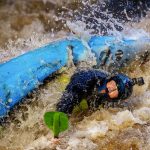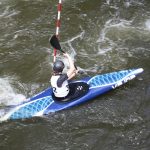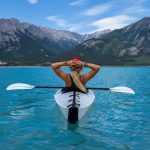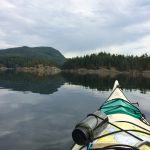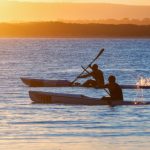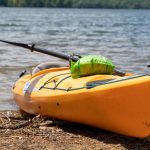A Personal Flotation Device (PFD) is your lifeline on the water. It should keep your head above the water when things go wrong.

With winter on the horizon, you might be thinking that it’s time to pack away the kayak and get ready for the snow. Winter kayaking means digging out your kayak in the cold months and finding the enthusiasm to get out on the water, and this can be hard work. The rewards of winter paddling make the effort absolutely worth it, though.
In reality, the winter months often aren’t as cold and wild as you might think. The hardest part of the day is often getting yourself out of bed while it’s still dark out, and loading up your kayak onto the roof to hit the lake by sunrise. Our winter kayaking tips will help you find that motivation and make sure you don’t miss out on some of the best kayaking months of the year.
Why Go Winter Kayaking
I don’t know about you, but I don’t really fancy the idea of taking several months off kayaking throughout the winter. But a lot of kayakers do. Sure, we’d love it if more kayakers took to the water year-round, but we would be lying if we didn’t say that one of the reasons we love winter kayaking is the quieter lakes and rivers.
You don’t have to battle in the parking lot to get a space. Then you have the whole lake to yourself. It’s a level of tranquility that you have to travel for in the summer and while we aren’t trying to be anti-social, there are some days when it’s great to get out and relax on your own private piece of water.
There are other benefits too. In certain areas, river levels come up as winter rolls around, though in others the water stays in the hills as snow and the rivers dry up completely. Then there’s the scenery. An early morning mist hanging over the lake, the orange-leaved trees, and the snow-capped mountains. Winter scenery really is hard to beat.
Is Winter Kayaking Dangerous?
Winter kayaking can be more dangerous than summer kayaking, sure. The water is considerably colder, there are fewer people around to help you out of a tight spot, and there’s less daylight to sort out issues if they do arise. But with a little planning and preparation, as well as the right gear, you can not just stay safe, but enjoy being out on the water.

There is, however, no getting around the temperature. Winter is unlikely to be the time to go ahead and try out kayaking for the first time, or to take young kayakers out on the water. Most youngsters find they have as much fun in the water as they do on it, and unless you’re particularly hardy – or perhaps Scandinavian – you’re unlikely to want to spend your days swimming around a frozen lake.
Winter Kayaking Tips
So you’re still keen to get out on the water? That’s great news. These winter kayaking tips will help you stay safe and comfortable and keep getting out in all weather.

Check the Forecast
The most important part of any winter kayaking adventure happens before you even leave the comfort of your house. You have probably made a plan of where you want to go, either on your own or with your buddies. But plans should be flexible. When you’re sitting and drinking your morning cup of coffee, double-check the weather forecast for your day.
Forecasts in winter are often less reliable than they are in the summer. The weather can change in an instant and this can affect your day in any number of ways. Perhaps the river may swell, or the wind could swing from another direction, or what was forecast as rain might fall as sleet. Keep checking the forecast, but be ready for it to be only a vague representation of what you will experience.
Layer Up
With changeable weather on the cards, layers of clothing are your friend in the winter. For a start, layers tend to be warmer anyway. By layering clothing, you create multiple extra layers of trapped air, which can warm up and insulate you from the air temperature. This includes all areas of your body, right down to wearing woolen socks inside your kayaking booties.
But layers have a second and probably more useful advantage. It’s not uncommon in winter to start the day in frigid temperatures where you need all the clothing you can find, then throughout the day warm up, and then find that the temperature drops again late in the afternoon. By layering your clothing you can quickly adjust it to suit these varied temperatures and prevent you from either freezing or sweating out into your clothes, which can cause you to cool down quickly.
Warm Up
The words ‘warm up’ might bring back some buried memory of high school gym class. Unfortunately, that whistle-toting gym teacher of yours was onto something and a warm-up really is worth feeling a little ridiculous for five minutes. Let’s face it, in winter you’re more likely to suffer an injury, so getting the blood pumping before you take to the water is never a bad idea.
Your warm-up can be something as simple as some jumping jacks or jogging on the spot. If you’re about to get into something technical, or into strong winds where you need to be active from the start, you might want to think about getting your arms moving more and getting stretched. The added bonus here is that as the blood pumps around your body it warms you up, so you’re less likely to climb onboard your kayak and feel frozen.
Swap for a Sit-In
We know how much you love your sit-on-top kayak, and we’re totally with you. But when it comes to winter kayaking, the sit-in kayak definitely holds the advantage. The high sides and sit-in design give you better protection from the weather and from waves, keeping your legs warmer.

That said, there is one major advantage to the sit-on-top and that is stability. Sit-in kayaks are usually narrower than sit-on-tops and have less primary stability, so they’re not quite as stable. Sure, it’s great to be more protected from the wind and the waves, but if that means you’re more likely to fall in then perhaps it’s worth sticking with the sit-on-top and finding other ways to stay warm.
Get a Spray Skirt
If you do make the change to a sit-in kayak, or if you’re already there, then the spray skirt is a must-have winter accessory. By closing off the top of your cockpit you stop splashes and spray from entering your kayak and soaking your legs. But you also turn your kayak into a cocoon of sorts, where the warm air generated by your legs stays inside the kayak and helps to insulate you.
Spray skirts come in two main styles, nylon and neoprene. Neoprene spray skirts are warmer and more waterproof than their nylon counterparts, but beginners definitely benefit from how easily you can remove a nylon spray skirt if you capsize. Remember, even when you’re looking for the warmest option, safety should still be at the top of your priorities.
Insulate your Butt

There is very little in this world that is worse than having a cold butt. I can’t tell you the number of days of winter kayaking where I’ve longed for a little more butt insulation, so keep your keister well insulated.
Many modern seats are foam-heavy, and this helps to insulate you from the butt up. But if you have an aerated seat, or a more basic plastic seat, you can add to your comfort and warmth with a little homemade insulation. An old camping foam pad cut to shape and attached – even just with some gaffer tape – adds a load of insulation and can be easily removed for the following summer. Trust us on this one, a warm butt is worth the effort.
Put a Hat On
You want to have insulation at the other end, too. Sure, the old saying that you lose 80% of body heat through your head might not be true, but that doesn’t mean you don’t lose any. Speaking as someone whose hairline is making a quick break for the exit, the value of a good winter hat should not be underestimated.

I have a box in my garage that contains hats of all styles, from woolen to fleece and even a few waterproof hats. Different hats suit different occasions and different heads. And if you find that your head is getting too warm, you can always tuck your hat down the back of your PFD until you need it again. There’s nothing wrong with wearing a cap if it’s sunny too.
Paddle Drip Rings
There are very few feelings that evoke such a strong reaction as a drip of water running all the way from the tip of your paddle blade, down the shaft, up your wrist, and all the way to your elbow or beyond. Okay, there are worse things in the world, but feeling a single droplet go all that way is bad enough once. What about an entire day of that?
Paddle drip rings are fitted on most recreational kayak paddles and help to redirect the water away from your hands and wrists. Make sure these are positioned outside of your hands, but not so wide that they dip in the water as you paddle. Drip rings can be retrofitted to split paddles. If you’ve got a one-piece paddle without drip rings, some ¼ inch bungee tied around the paddle can go a long way to redirecting droplets.
Wear Gloves or Pogies
Your hands are arguably the most important part of your body when you’re kayaking. Cold hands are hard to hide. They need to stay on your paddle all day and are fully exposed to the elements. A pair of neoprene gloves are a worthwhile investment – and not an expensive one – for winter kayaking. Neoprene gloves with a cutout palm are usually preferred, as they give you a better feel of your paddle.
Alternatively, try a set of pogies. Pogies are usually either made from neoprene – for white water or wetter environments – or nylon with some fleece inside them. These attach to your paddle shaft with velcro and then you slide your hand into the pogie to grip your paddle. Pogies are popular with sea kayakers and river paddlers because you can feel more through your paddle that you can lose with gloves, but they can be a bit strange to get used to.
Upgrade to a Drysuit
The drysuit is seen by many to be the ultimate piece of kayaking equipment. The thought that you can fall into the water and stay dry means that many river kayakers and sea kayakers upgrade as soon as they can warrant the expense. And they are absolutely worth the money, especially if you plan to push your skills through the winter and risk falling in. Take a look at our post about various drysuits available on the market.
But remember that a drysuit is just a waterproof layer. It doesn’t insulate you well at all. I’ve seen plenty of kayakers misjudge their layers underneath a drysuit and end up spending the day cold. Once you’re in a drysuit it’s harder to change your layers and often if you’re heading out fishing, or for a cruise on a calm lake, you would be better with layers and a waterproof cag than a full drysuit.
Stay Active
The best way to stay warm on the water is to keep moving. This keeps your blood flowing around your body and helps you to stay warm. Sure, it can be great to sit and take in your surroundings a little, but sit for too long and you’ll find that you cool down quickly.

Plan your day to take in a journey and explore, and if you’re at risk of getting cold you can always hop out on the bank and stretch your legs to get the blood flowing. If you’re planning a high-octane, heavily active day, you may choose to start in fewer layers in the knowledge that you will warm up. But even on a relaxed day, try to stay moving or at least keep your fingers and toes wriggling to keep a little blood flowing to your extremities.
Carry a Headlamp
Getting caught out by the lack of daylight happens to the best of us. As winter rolls around the days suddenly become far shorter and night comes around quicker than you ever think. Keeping a headlamp on hand – either a waterproof one in your PFD or stowing one in a dry bag – is always worthwhile in winter.
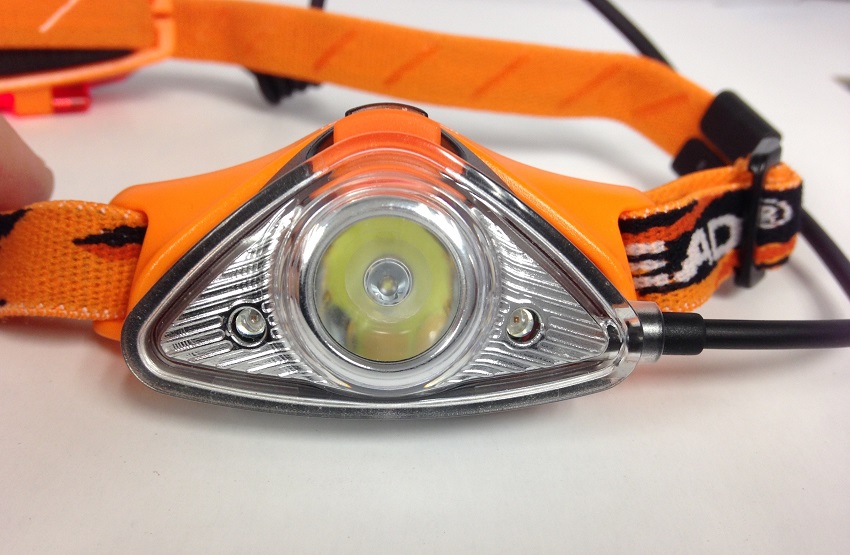
In reality, the most common time you use your headlamp is when you’re loading up, or unloading your gear from the car. At the start of winter, add a headlamp and spare batteries to your kayaking gear, that way you won’t have to remember it for each trip.
Have your Gear Ready to Go
As we said at the start, sometimes the hardest thing about winter kayaking is finding that motivation to get out of bed and get going. Probably the best way I have found around this is to have my kayak loaded and my gear all ready to go the night before. That way, I can get up, make a coffee, climb into my van and get on the road before my body has had a chance to catch up.
I can safely say that I have never once regretted a winter kayaking day. What I have regretted is choosing to stay in the warmth of my bed and watching the opportunity pass me by. But sometimes it takes a little trickery to get ourselves out of that warmth in the morning.

